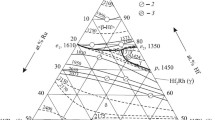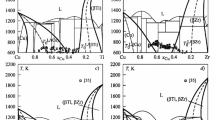Abstract
The extension of metastable solid solubility limits of Ti, Zr, and Hf in hcp rare earth elements Gd, Tb, Dy, Ho, Er and Lu, including Sc and Y, were obtained by quenching alloys from the liquid state Both the solubilities of Zr and Hf in host matrices were increased enormously beyond their equilibrium solubilities, however little increase can be made for Ti as the solute. The large extension of the solubility limits by quenching from the liquid state was attributed to the three unique factors associated with the liquid quenching, namely the high mutual solubility in liquid state, the phase transformation of L →β →α′ (martensite) and the high cooling rate. However, the retainable metastable solubility at room temperature is invariant as long as the cooling rate is sufficiently high enough to carry theβ →α′ transformation. The resulting solubility limits are described as theUltimate Solubility Limits (USL) for the hcp structure and refer to the maximum amount of the solute that can be dissolved in the matrix without immediate depletion at room temperature. A correlation of this USL to the size factors and the relative axial ratios (c/a) between the solute and solvent of 24 alloy systems was established. The strong correlation of these limits to the c/a ratios is due to the strain-induced mechanism of phase transformation.
Similar content being viewed by others
References
K. A. Jackson:Can. J. Phys., 1958, vol. 36, p. 683.
V. T. Borisov:Soviet Phys. Dokl, 1962, vol. 7, p. 50.
A. A. Chernov:Growth of Crystals, Consultants Bureau 1962, vol. 3, p. 35.
R. Wang:Appl. Phys. Letters, 1970, vol. 17, p. 460.
R. Wang:Met. Trans., 1972, vol. 3, p. 1213.
B. J. Beaudry and A. H. Daane:Trans. TMS-AME, 1963, vol. 227, p. 865.
R. R. Joseph and K. A. Gscheidner, Jr.:Trans. TMS-AIME, 1965, vol. 233, p. 2063.
K. A. Gschneidner, Jr., 0. D. McMasters, D. G. Alexander, and R. F. Venteichev:Met. Trans., 1970, vol. l,p. 1961.
R. Beck: Unpublished information quoted by K. Gschneidner, Jr., “Rare Earth Alloys,” D. Van Nostrand Co., Inc., Princeton, N.J., 1961, p. 325.
R. Wang: University of Southern California, unpublished research, 1972.
J. K. Mackenzie and J.S. Bowles:ActaMet, 1957, vol. 5,p. 137.
A. G. Crocker: Ph.D. Thesis, Sheffield University, 1959.
P. Gunt and J.W. Christian:Acta Met., 1959, vol. 7, p. 534.
C. H. Hodges:Phil. Mag., 1967, vol. 15, p. 371.
C. H.Hodges:ActaMet., 1967, vol. 15, p. 1787.
C. C. Koch:J. Less-Common Metals, 1970, vol. 22, p. 149.
R. Wang, S. K. Hsiung, and G. H. Narayanan: University of Southern California, unpublished results, 1973.
Author information
Authors and Affiliations
Additional information
R. Wang, Formerly Assistant Professor, Department of Materials Science, University of Southern California, Los Angeles, Calif.
Rights and permissions
About this article
Cite this article
Wang, R., Kim, Y.B. Metastable solubility limits of primary HCP solid solutions quenched from the liquid state. Metall Trans 5, 1973–1977 (1974). https://doi.org/10.1007/BF02644488
Received:
Published:
Issue Date:
DOI: https://doi.org/10.1007/BF02644488




